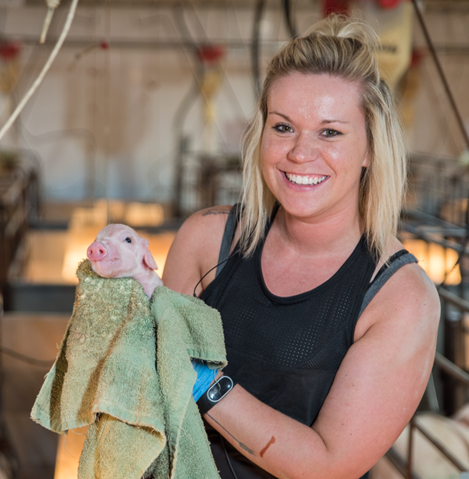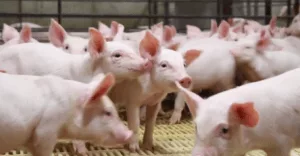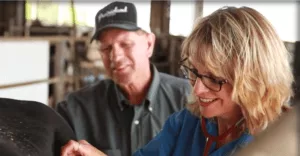Animal Health

Animal health is key to healthy people and a healthy planet .
Farm animals not only provide an important source of protein and other nutrients for families around the world, but raising livestock and poultry provide livelihoods for farmers – many in developing countries who rely on animals to feed their families and elevate them out of poverty with income that then supports local economies and educational opportunities. The impact is truly immeasurable.
That’s why animal health is vital.
So much goes into keeping farm animals healthy. It’s 24/7 work for farmers and ranchers and a team of nutritionists, veterinarians and others who work hard to make sure we all have access to safe, wholesome meat, milk and eggs. There are many tools in their collective toolbox to provide an important source of protein to families everywhere. Among them: balanced and tailored nutrition, antibiotics and vaccines.
Housing
Housing is important, too. On many farms today, livestock and poultry are housed indoors. The innovation in those buildings is impressive and allows access to quality nutrition and high standards of comfort and care for the animals.
For example, many buildings are climate controlled and, in some barns, feed and water are automated so animals get the right amount of specially formulated feed and continuous access to clean, fresh water. Farmers can monitor conditions on computer panels in the barns and from their laptops or mobile phones. Barns are properly ventilated and routinely cleaned. Manure is responsibly captured and often used to fertilize crops that, in turn, are used to feed the livestock in a sustainable, continuous cycle. On some farms, manure is captured in methane digesters that convert manure to fuel. That fuel can then be used to power vehicles and provide electricity for area power companies.

It’s an environment that allows farmers, nutritionists, veterinarians and others to monitor animal health more easily. For example, because feed is automated, they’re able to determine the amount of feed animals are consuming. If an animal isn’t eating enough, it can indicate potential illness that can then be immediately addressed. Indoor housing protects animals from predators, inclement weather and diseases, too.
Not all animals are housed indoors. On many dairy farms, for example, cows are housed in barns with open sides for full ventilation. Some have sand beds in individual stalls and cows are free to wander to the feeder and water tanks. When temperatures rise, there are fans and sprinklers to cool the cows. When the weather turns cold, a cow’s body heat will suffice. A cow’s normal body temperature is about 102°F, so several cows in a barn can produce a great deal of heat.
Biosecurity
Keeping animals healthy includes taking many measures on a farm to keep diseases from coming onto or leaving the farm. Diseases can cause animal suffering and death, take an emotional toll on farmers and ranchers, impact our food supply, and affect our economies when losses impact a farmer’s income.
Bacteria and viruses can enter a farm or ranch by way of contact with sick humans or other animals, even if they don’t appear ill. They can also be spread by wild animals and migratory birds. You may have heard of bird flu, more formally known as Highly Pathogenic Avian Influenza (HPAI), which is often carried by migratory birds. When chickens or turkeys are infected with this highly contagious disease, there is no way to treat them. To make sure the disease doesn’t spread to neighboring farms, farmers must humanely euthanize flocks. It’s an incredibly difficult situation.
Another serious illness impacts pigs. Porcine reproductive and respiratory syndrome, or PRRS, outbreaks spread rapidly and can quickly result in death. Strategies such as vaccines are routinely used to reduce mortality caused by this virus, but there are times when more severe measures need to be taken to prevent other animals from suffering from disease.
So how do farmers protect their animals? They put biosecurity protocols in place to reduce the risk of diseases entering – or leaving – their farms. This helps keep their livestock and poultry safe from illness that may enter on boots and clothing or from wild birds, animals or rodents. By minimizing the spread of disease, good biosecurity also helps keep animals on other farms safe.
A first step to preventing the spread of disease is housing animals and poultry indoors. Extra precautions may also be taken. For example, on many pig and poultry farms, farmers, veterinarians and other visitors are required to shower before entering barns and asked to wear clean, disposable coveralls, foot coverings and hair nets. They’re then required to shower before they leave the barn. In farm-speak, this is referred to as “shower in – shower out.”
In some instances, those driving into and away from a farm are required to wash their tires when entering and leaving the property – especially those vehicles visiting multiple farms.
Many of us have enjoyed experiencing farm animals at county and state fairs and other events. When farmers leave those events, they’ll often separate these animals from the main herd or flock at home, quarantining them for a couple of weeks to ensure they’re healthy before allowing them around other livestock or poultry.
Farmers and veterinarians carefully monitor animals and poultry each day. Doing so allows them to quickly identify if livestock like dairy cows, beef cattle, pigs or birds, are sick, separate them and then take appropriate action to treat them.
Biosecurity is vital to protecting animals and our food supply. So when you drive by a farm and see gated entries and “do not enter” and stop signs, it’s because farmers are doing all they can to make sure their herds and flocks stay healthy, which helps reduce the need for antibiotics and ensure neighboring farms stay healthy, too.
Nutrition, medications, high-tech housing, biosecurity and more. It’s all part of what’s more formally called “animal husbandry,” the day-to-day science-based care, selective breeding and raising of livestock and poultry. Although it’s lots of hard work, most farmers and ranchers simply see caring for the resources that have been entrusted to them as a privilege and honor.


